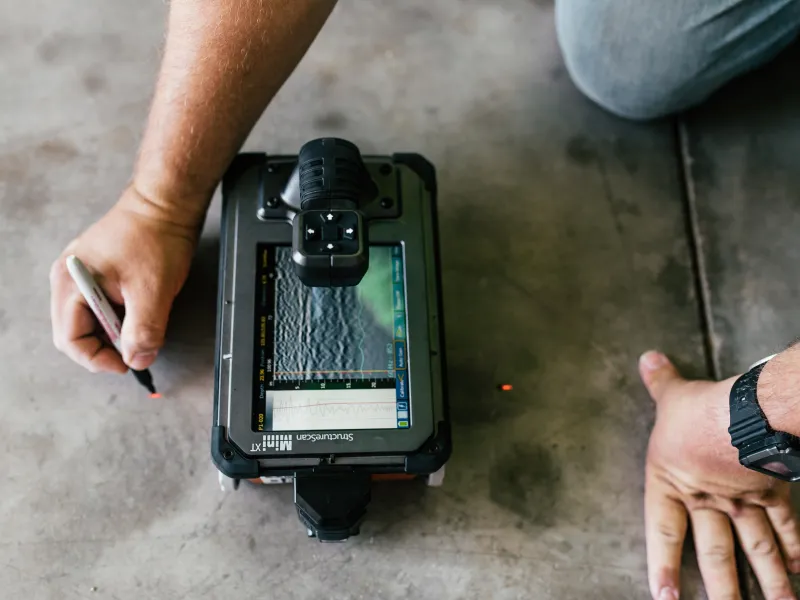Enhance Construction Safety And Security with Professional Concrete Scanning
Enhance Construction Safety And Security with Professional Concrete Scanning
Blog Article
Unveil the Transformative Power of Concrete Scanning in Making The Most Of Efficiency and Safety And Security
Concrete scanning has actually arised as a vital tool in the building market, providing unrivaled benefits in improving project efficiency and making sure security requirements. The transformative power of concrete scanning lies in its ability to offer real-time data and detailed insights, transforming just how jobs are planned and carried out.
Relevance of Concrete Scanning
Guaranteeing the architectural integrity and safety of construction projects starts with the essential step of performing comprehensive concrete scanning. Concrete scanning is a non-destructive approach made use of to identify and map subsurface components within concrete structures.
Furthermore, concrete scanning assists in enhancing project timelines and spending plan by staying clear of unanticipated prices and hold-ups that might emerge due to unanticipated blockages within the concrete. Eventually, investing in comprehensive concrete scanning is a proactive method that boosts both effectiveness and security in building projects.
How Concrete Scanning Functions
Concrete scanning runs as an important tool in building projects by using innovative innovations to detect and map subsurface aspects without triggering architectural damages. Ground Penetrating Radar (GPR) and Electromagnetic Induction (EMI) are 2 primary techniques utilized in concrete scanning. GPR works by emitting high-frequency radar pulses into the surface, which bounce back when they come across subsurface items or spaces. The time considered the signal to return shows the deepness and place of the objects. EMI, on the various other hand, uses electromagnetic fields to identify differences in material compositions, such as identifying rebar or channels within concrete frameworks.
Throughout the scanning procedure, the data collected is analyzed in real-time, allowing instant recognition of prospective hazards or barriers under the surface area. This details aids in decision-making, making certain that construction activities proceed securely and efficiently. In addition, 3D imaging software can be utilized to produce thorough maps of the subsurface elements, even more improving project preparation and execution. By utilizing these advanced technologies, concrete scanning substantially reduces the risk of expensive damages and injuries on building and construction websites.
Benefits of Concrete Scanning
Utilizing advanced scanning technologies in building tasks provides a plethora of benefits, enhancing both efficiency and security on-site. Among the key advantages of concrete scanning is the capacity to discover and locate embedded things such as rebar, post-tension wires, and conduits accurately. By recognizing these components before drilling or cutting right into concrete frameworks, the threat of unexpected strikes is dramatically decreased, avoiding possible injuries to workers and damages to the structure itself. Concrete scanning helps in preparation and developing more efficiently, as it offers specific information concerning the location and deepness of structural parts.

Instance Research Studies: Concrete Scanning Success

In one more case, a building and construction firm utilized 3D concrete scanning to analyze the condition of aging concrete frameworks in a historical structure. The thorough scans offered valuable insights right into the degree of damage and assisted prioritize upkeep initiatives successfully. By proactively dealing with locations of issue recognized via scanning, the firm was able to extend the lifespan of the structure and ensure resident safety.
These study emphasize the transformative power of concrete scanning in boosting efficiency, precision, and security in building and construction projects.
Executing Concrete Scanning in Projects
Carrying out sophisticated scanning modern technologies during construction tasks has actually ended up being increasingly essential for enhancing precision and security. By integrating concrete scanning right into project preparation and execution, building teams can recognize possible hazards, such as rebar or post-tension cords, concealed within concrete structures. This aggressive strategy minimizes the risk of crashes, delays, and pricey rework, inevitably resulting in more effective project timelines click here to find out more and spending plans.
To carry out concrete scanning efficiently, job managers should team up closely with seasoned scanning experts to determine one of the most suitable scanning methods for the details task needs. Engaging scanning experts from the onset of a job makes it possible for the team to develop detailed scanning strategies that attend to vital locations of worry and guarantee comprehensive data collection.
Moreover, incorporating concrete scanning right into routine task workflows can streamline decision-making procedures, as real-time check information provides prompt insights right into the problem of concrete frameworks - Concrete Scanning. This data-driven technique helps with educated problem-solving and enables groups to make modifications promptly, promoting a culture of efficiency and safety and security throughout the project lifecycle

Conclusion
Finally, concrete scanning plays a crucial role in enhancing performance and safety in pop over to this site building jobs. By using advanced modern technology to find and map out underlying structures within concrete, this procedure aids to stop expensive mistakes, ensure structural honesty, and reduce dangers on website. With the capability to reveal covert components and offer exact information, concrete scanning confirms to be a beneficial device for maximizing project results and optimizing general success.
Concrete scanning is a non-destructive approach made use of to detect and map subsurface components within concrete frameworks. In addition, concrete scanning assists in enhancing job timelines and spending plan by avoiding unexpected prices and delays that might occur due to unexpected obstructions within the concrete. One noteworthy situation research study includes a large-scale renovation task where concrete scanning played a critical role in guaranteeing task success.In another situation, a construction firm utilized 3D concrete scanning to analyze the problem of aging concrete frameworks in a historic structure. By incorporating concrete scanning into job planning and execution, construction groups can determine potential dangers, such as rebar or post-tension cable televisions, concealed within concrete frameworks.
Report this page